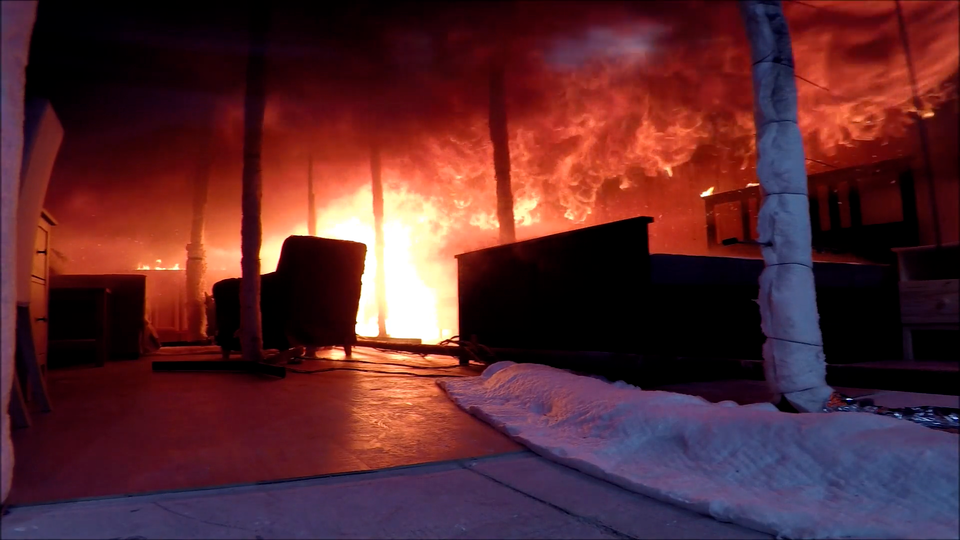When it comes to firefighting, the worst flames are the ones you often do not see coming. The warning indications of flashover, a fatal fire phenomenon when almost all flammable things in a room suddenly ignite, can be hard to see among the commotion of a burning structure.
 A view from NIST’s Burn Observation Bubble (BOB) of a burning structure during an experiment, one minute before flashover. Image Credit: NIST
A view from NIST’s Burn Observation Bubble (BOB) of a burning structure during an experiment, one minute before flashover. Image Credit: NIST
One of the main causes of firefighter fatalities is flashover, but a recent study indicates that artificial intelligence (AI) could give first responders a much-needed heads-up.
A Flashover Prediction Neural Network (FlashNet) model has been built by researchers at the National Institute of Standards and Technology (NIST), the Hong Kong Polytechnic University, and other institutions to detect the deadly occurrences seconds before they explode.
In a recent study that was published in Engineering Applications of Artificial Intelligence, FlashNet outperformed existing AI-based flashover forecasting tools, boasting an accuracy of up to 92.1% across more than a dozen popular home floorplans in the U.S.
At around 600 °C (1,100 °F), flashovers commonly appear and can cause temperatures to shoot up further. Existing research techniques either depend on continuous temperature data streams from burning structures to predict these events or utilize machine learning to fill in the gaps when heat detectors fail due to high temperatures.
The majority of machine learning-based prediction tools up to this point, including one the authors have created, have been trained to function in a single, standardized context. In practice, firemen do not have this privilege.
They may have little to no knowledge of the layout, the location of the fire, or whether or not doors are open as they rush into enemy territory.
Our previous model only had to consider four or five rooms in one layout, but when the layout switches and you have 13 or 14 rooms, it can be a nightmare for the model. or real-world application, we believe the key is to move to a generalized model that works for many different buildings.
Wai Cheong Tam, Study Co-First Author and Mechanical Engineer, National Institute of Standards and Technology
The researchers strengthened their strategy with graph neural networks (GNN), a type of machine learning algorithm adept at making decisions based on graphs of nodes and lines, representing various data points and their relationships with one another. This was done to engage with the variability of real fires.
GNNs are frequently used for estimated time of arrival, or ETA, in traffic where you can be analyzing 10 to 50 different roads. It is very complicated to properly make use of that kind of information simultaneously, so that is where we got the idea to use GNNs.
Eugene Yujun Fu, Study Co-First Author and Research Assistant Professor, Hong Kong Polytechnic University
Fu added, “Except for our application, we are looking at rooms instead of roads and are predicting flashover events instead of ETA in traffic.”
A majority of the residential building stock in the United States was represented by the researchers’ computational simulations of more than 41,000 fires in 17 different types of structures.
Along with layout, other variables included the place of the fire, the type of furniture, and whether or not doors and windows were open. They gave the GNN model a collection of about 25,000 fire instances to investigate, followed by 16,000 for fine-tuning and final testing.
The new model’s accuracy tended to depend on the amount of data it had to ponder as well as the lead time it sought to provide firefighters.
However, the model beat five other machine-learning-based tools, including the authors’ earlier model, with an accuracy of, at most, 92.1% with 30 seconds of lead time. In terms of false negatives, the tool yielded the fewest risky situations when the models failed to identify an impending flashover.
The authors placed FlashNet in situations where it had no prior knowledge of the particulars of a structure and the fire blazing inside of it, akin to the predicament firemen frequently encounter.
The tool’s performance was fairly encouraging in light of these limitations, Tam added. The writers still have to go a long way before they can bring FlashNet to a successful conclusion. The model will then be put to the test using actual data rather than generated data as a further stage.
Tam added, “In order to fully test our model’s performance, we actually need to build and burn our own structures and include some real sensors in them. At the end of the day, that is a must if we want to deploy this model in real fire scenarios.”
Journal Reference:
Tam, W. C., et al. (2022) A spatial temporal graph neural network model for predicting flashover in arbitrary building floorplans. Engineering Applications of Artificial Intelligence. doi:10.1016/j.engappai.2022.105258.
Source: https://www.nist.gov/